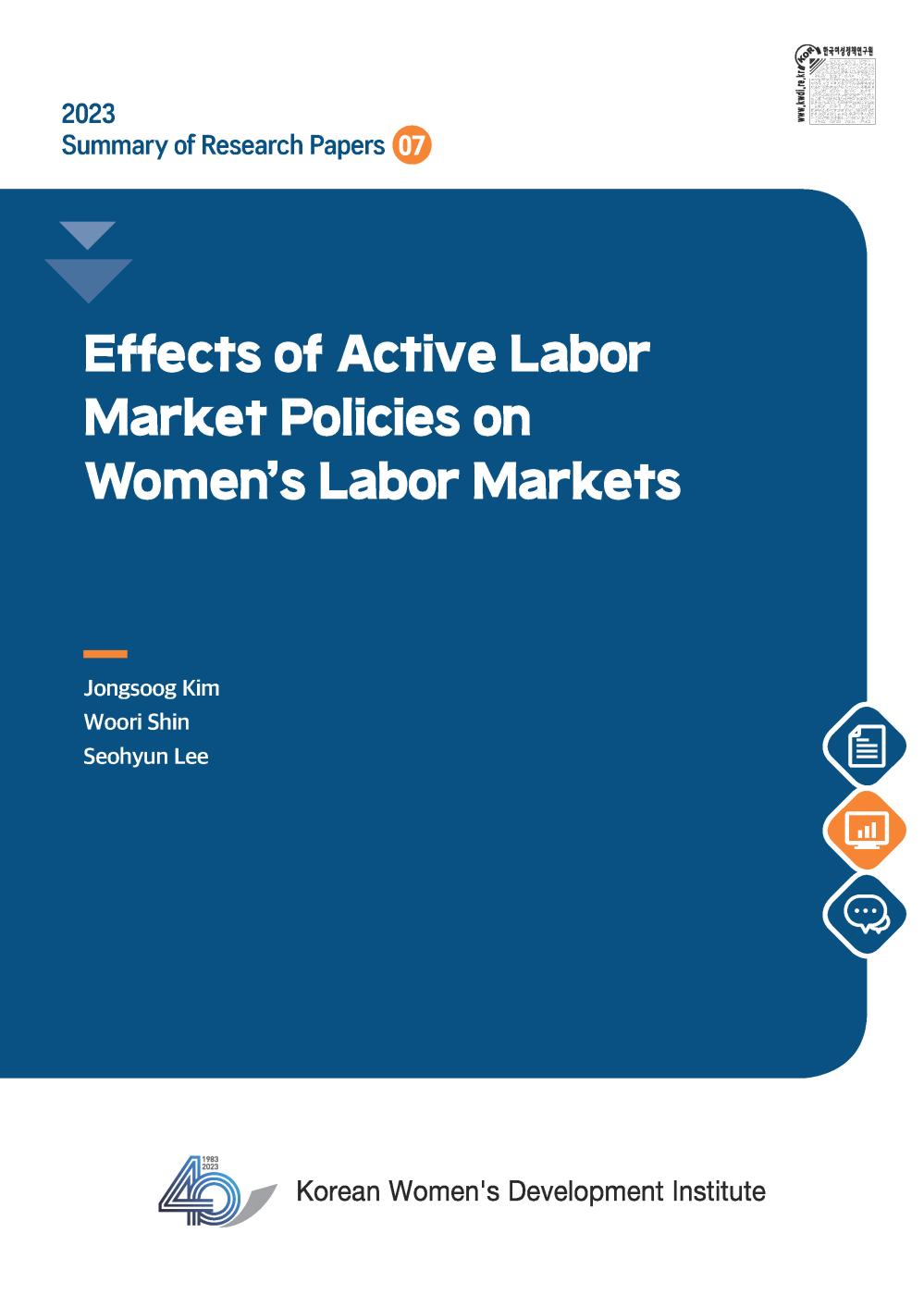Report
| Study on the effect of active labor market policies on women’s labor markets | |||
|---|---|---|---|
| Type | Basic | Period | 2023 |
| Manager | Jongsoog Kim | Date | 2023-12-29 |
| Fiie | 07_적극적 노동시장 정책의 여성 노동시장 영향 연구.pdf ( 1.75 MB ) | ||
|
Abstract Study on the effect of active labor market policies on women’s labor markets Jongsoog Kim Woori Shin Seohyun Lee
This study aims to understand the relationship between the women’s labor market and women’s participation in active labor market policy. Policy includes direct placement in jobs, vocational training, employment services, and employment incentives. Data utilized were the evaluation results of South Korean government policies and the DW Employment and Labor Administration of the Korea Employment Information Service. Information from the administration is linked with a policy participant database using individuals’ employment history of employment insurance. It also includes information on vocational training, unemployment benefits, and employment placement. In addition, we utilized an unbalanced panel derived from the OECD Statistical Database to analyze the results of active labor market policies in foreign countries.
South Korea’s total active labor market policy budget increased from 2018-2021 by about 58.7% to 30.5 trillion KRW, with a relatively large increase in 2020-2021 due to COVID-19. The number of men and women participating in vocational training and employment services decreased, showing that the major trend moved toward supporting the cost of human resources through support for direct employment. The main objective of active labor market policy had traditionally been increasing employment possibilities.
Next, utilizing DW Employment and Labor Administration data, we analyzed the effect of policy on employment and remuneration on 8 groups. We used the PSM (Propensity Score Matching) method to solve the problem of selection bias, and the matched sample was analyzed using logit regression. The employment probability of the groups within 6 months ranked from highest to lowest as follows: First, those who received training, job placement, and unemployment benefits. Second, those who received training and unemployment benefits. Third, the group that received training and job placement. Employment probability within 12 months showed that the effect of training and mediation was relatively low compared to the entire sample. Meanwhile, the remuneration of the group that received training and unemployment benefits was statistically, significantly positive, compared to those who did not participate in any policy. This shows that the effectiveness of unemployment compensation on the level of later reemployment remuneration had more impact on this group compared to the entire group. Overall, the analysis results of active labor market policies for women are not very consistent. This may largely be attributable to heterogeneity among women, while at the same time, it may be due to the 10% sample analysis.
An analysis of the active labor market performance of OECD countries was conducted by constructing an unbalanced panel using unemployment rates, macro variables, active labor market policy variables, institutional data, and variables related to the women’s labor market from 1990-2020 in the OECD statistical database. The effect of the ALMP on the female unemployment rate did not have a significant effect on total expenditure. However, in concrete, project-specific expenditures, the effect on the total amount of expenditure was somewhat different. Although only direct job creation and start-up support were significant in the overall unemployment rate, employment services have a very significant negative (-) effect on the female unemployment rate. This confirms that employment service policy is more useful for women.
The main implications obtained through this study are as follows: First, the performance of packaged active labor market policies is better than separate, individual policies. In the future, the performance of policy combinations should be evaluated periodically. A variety of active labor market policy menus would make it possible to design a detailed policy package based on individual needs to improve employment and working conditions. Second, the result of the OECD analysis was that public employment service policies can be effective for women. However, it is important to note that East Asian and Eastern European countries have low women’s unemployment rates and also low employment rates due to women’s high rate of unpaid labor. Also in South Korea, career interruption for women is a serious problem. Since the policy for job seekers has limitations in easing their exit from the labor market, it is necessary to both widen and activate policy goals. Third, women are the majority of the vulnerable class in the labor market, so labor market policies based on their vulnerability should be prioritized. Policies that can overcome employment and career development disadvantages based on existing gender labor market structures should be promoted and continue for a considerable period of time. Disadvantages to women include vulnerability to long-term unemployment, jobs that are divided according to gender, and disadvantages stemming from balancing work and family during childbirth and child-rearing. Fourth, although there are employment services, it is necessary to conduct gender-sensitive reviews throughout the entire process of policy implementation. In particular, people who have been unemployed for a long time might not be seeking employment, so they may be systematically omitted from the target of policy. At each stage of the decision-making process of establishing and implementing policies, it is necessary to prepare a system that reflects the relevant issues.
Research areas: labor and employment Keywords: active labor market policy, women’s employment, labor market, OECD countries |
|||
